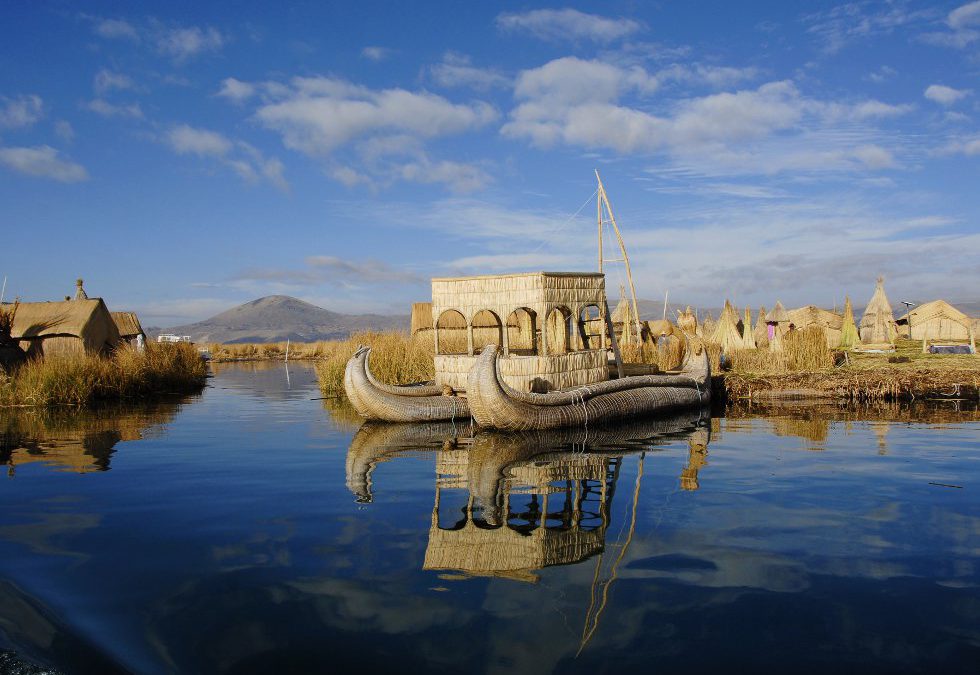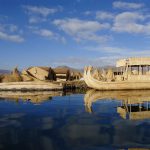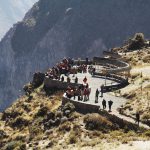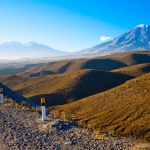Upon first glance across the calm blue waters you might be wondering why there is a sea in the middle of the Andean mountains. Nestled between Peru and Bolivia at more than 12,500ft. above sea level and stretching 120 miles is the spectacular and sacred Lake Titicaca.
The impressive mountain lake landscape of Lake Titicaca holds a number of hidden wonders and mysteries that are yet to be discovered.
Of particular interest among travelers to the region of Puno are the floating islands of Lake Titicaca and the Uros tribe which populates the islands. You may remember that one particular traveler from the United States, Donald Duck, decided to share his experience at Lake Titicaca with you back in the 1950s, and we feel this is a great way to introduce you to this beautiful destination in Peru.
The Mysterious Uros Tribe
Before exploring the islands of Lake Titicaca, it is important to explore who the people are that inhabit these floating islands. The Uros tribe are said to be descendents of the first Andean settlers, the Urus, although their origin is still contested and enveloped by mystery, fascinating researchers for years.
According to local legends, the Uros existed before the sun, when the Earth was still dark and cold. This gave them ‘black blood’ meaning that were able to withstand the cold Andean temperatures and weather conditions!
Perhaps more concrete than local legend; we can look at the possible reasons for the Uros deciding to live on the surface of Lake Titicaca. Some research suggests that the Uros began living amongst a predominantly Aymara and Quechua population in the Andes. As the Uros were a minority they were on the receiving end of successive invasions by these other, larger indigenous populations. Unable to find their own land to tend, the Uros looked to the lake for both protection and sustenance, and consequently constructed the small floating reed islands that you are able to see today.

Watch your step!
Have you ever thought walking on a water bed is just not exciting enough? Well, how about walking on a whole floating island made out of reeds! Dried bundles of totora reeds from the shores of Lake Titicaca are taken by the Uros and tightly woven into boats, houses, crafts, food and even the islands themselves. When looking at the Uros islands you may be wondering how they actually float and support the weight of the people living on it and the buildings. The totora reeds begin decomposing from the bottom up, releasing natural gasses that actually causes the islands to float…although knowing the cold waters of Titicaca, we wouldn’t want to be one of the first to have tried this method out!
If you’ve ever complained of having to replace the light bulbs in your house, or cleaning out the gutter in Fall; you would probably not enjoy life on one of the 40 or so reed islands on Lake Titicaca!
The reeds decompose quite rapidly meaning that those living on the islands need to constantly add layers of reeds to maintain its stability. To provide anchorage, large logs are drilled through the island to the base of the lake with ropes attached in order to ensure that when the Uros go to sleep they don’t wake up on the other side of the lake!

Totora or Bust!
Totora reeds provide the Uros with a place to live, shelter in the form of the houses they build as well as transport with their incredibly elegant reed boats. They also are used for medicinal purposes, as they claim that when wrapped around a painful part of the body, the pain is said to simply vanish. The flowers of the reeds are used to brew tea and the iodine produced by the reeds us extracted and sold. If you visit Lake Titicaca on a hot day, you may be handed a totora reed to place on your forehead as when the reed is split open it is said to give off a cooling sensation.
Totora reeds form a central and vital part to the Uros’ daily life, culture, livelihood and indeed their survival.
However, the survival of this unique culture is reliant on the life of the totora reed. When El Niño devastated the region in the mid-80s, the islands were located further away from the shore. The lake’s water levels surged so high that it surpassed the islands’ ability to rise, and subsequently, the islands were destroyed, leading to one of the reasons why the floating islands of Lake Titicaca are today located closer to the shore. It is not just a rise in water levels the Uros need to worry about as following El Niño, drought hit the area. This decreased the growth of the totora reeds, leaving the Uros unable to patch their houses and maintain the islands.

Thanks for visiting our Central & South America Travel Blog! Feel free to contact one of our Travel Specialists via email, phone or chat to plan your perfect Peru itinerary.





